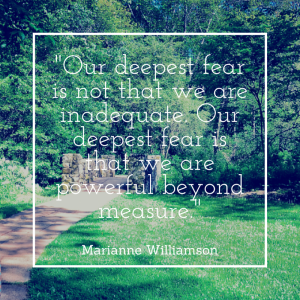
Nothing is more frustrating than when you’re trying to make positive changes in your life – improve the way you eat, exercise and take care of yourself – and no matter how hard you try to make a new habit stick, something seems to get in your way and you end up sliding off track. Right?
It’s easy to assume that it’s you; that you have this “problem” that can’t be fixed or that you must not be able to do it, that you’re hopeless or whatever story you tell yourself.
But that’s not true. And deep down, you know it.
After all, you’re a go-getter. You’re used to putting in the work and getting what you want.
So why isn’t this working??
“Inner chaos creates outer chaos” – Marie Forleo
When you’re trying to make room for a new future, it’s crucial that you first clear out the past, physically, mentally and emotionally.
Think about it this way, if our outer environment is a reflection of our inner world, then how is your environment supporting you? Or is it holding you back?
This week, I want to challenge you to start clearing out the clutter; to make room for the new. Because let’s face it, when you’re surrounded by chaos or you have a million and one things taking up space in your mind and your heart, it becomes really difficult to slow down, get clear and actually start doing the things that are important to you.
I’m going to walk you through the 3 different types of clutter that exist in our lives and then I’ll share powerful actions steps that you can start taking to create clarity and relief and get you out of that feeling of “stuck-ness” right now.
1. Physical clutter.
This is any clutter in our physical space. Like mail that’s piling up on the kitchen table, too many clothes, disorganized files, a messy purse, unable to find anything you’re looking for.
2. Mental clutter.
Mental clutter and physical clutter are directly related. Mental clutter makes us feel anxious, overwhelmed, and scatterbrained/disorganized. You know you have too much mental clutter when you find yourself constantly running late, forgetting why you just walked into a room, misplacing your belongings, multi-tasking, or feeling like your mind is always somewhere else (thinking of the next thing you have to do).
3. Emotional clutter.
This one is a bit more complex and is what I help my private clients with, in addition to the other aspects. Emotional clutter is heaviness in our lives associated with keeping everything in, not giving ourselves the opportunity to get our feelings up and out. Emotional clutter can weigh down on our spirits and our livelihood. And for many people, it’s often what leads them to use food for emotional reasons.
It’s not enough to just know about these things, you’ve gotta know what to do. So let’s get into it.
Clear the physical clutter.
It’s time to get rid of all that extra stuff that you’ve been hanging onto for too long now; the junk that keeps you feeling weighed down, stuck, exhausted. We often avoid thinking about it, but the truth is, it’s there and it’s weighing on our psyches and keeping us from feeling ease and clarity. Choose one area of your home (I suggest starting with your closet, but you can start wherever you’d like!) and start asking yourself questions like, “Is this supporting my life’s desires? My health goals? Does this, in its condition, make me feel good?” If the answer is no, get rid of it! Remember, clothes can always be donated.
** Side note: If you’re trying to lose weight and you just can’t bear the thought of parting with your too-small favorite pair of jeans, no problem. Keep them for now. BUT, go buy yourself a pair of jeans that is just as fabulous, makes you feel amazing/sexy/beautiful, and fits your body as it is right now. Because there’s nothing worse than your jeans pinching your sides to remind you that you’re not where you want to be. Trust me, this approach will only make you eat more, not less. **
Create mental white space.
This next exercise is a total game-changer, so definitely give yourself time to go through it and feel free to repeat it as many times as you’d like.
Give yourself between 10-20 minutes to write down EVERYTHING that you have to do, want to do or accomplish, including any daily tasks. Write it all – write the things that keep you up at night, that make you worry, the things that you want to do, the things that you feel like you’re supposed to do. Just get it all out there. The idea behind this exercise is to get all of those things that are occupying your brain space up and out so you can start doing more of the things you want to do, and spending less time feeling overwhelmed and stuck.
Next, organize your to-do’s in order of priority: what needs to get done today, this week, this month or this year. Once you have an idea of where your priorities lie, take a look at your list, what are the things you want to do? What are the things you don’t really want to do, but feel like you should do? (Hint: use your common sense here. None of us really want to pay back our taxes, but let’s face it, that’s something we have to do if you want to avoid trouble down the line). A better example of this would be something you agreed to do because you didn’t know how to say ‘no’ with class or you’ve said ‘yes’ to too many commitments, then it’s time to renegotiate your commitments and get them off your list. The point here is to challenge your assumptions of what you have to do and get crystal clear (and honest) about what you truly want to devote your life and time to.
Finally, choose just ONE thing that you want to get done from this list and commit! Make it happen.
This is a great place to start and I’ll be honest, this is some seriously powerful stuff right here. Give it a try and let me know what you think in the comments below! I’d love to hear which exercise you did and what you were able to accomplish!
To new beginnings!
Stephanie
P.S. If you feel like clearing the physical and mental clutter was a good place to start, but you’re looking for more, I’m happy to speak with you during a 50-minute Freedom Breakthrough session. This is your time to gain clarity and talk with someone (yours truly) who’s been where you are and has the experience to guide you through this. Let’s find a time that works for you.
 Do you ever feel like you’re “SO good” with food one day, and the next, you totally suck?
Do you ever feel like you’re “SO good” with food one day, and the next, you totally suck?








